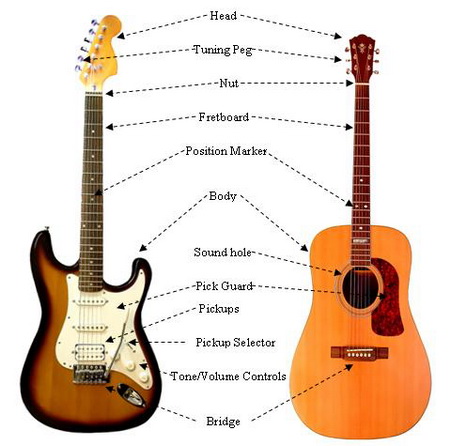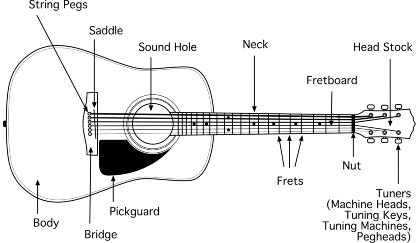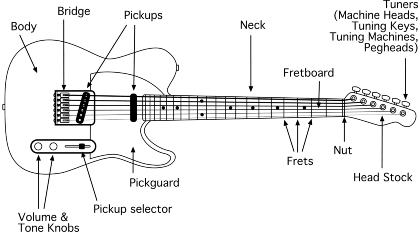One of the first things a guitarist need to know is regarding the parts of a guitar. Generally speaking, the parts of the a guitar are the same no matter the types and models of the guitar. Some guitars include:
- Electric guitar
- Bass guitar
- Acousic guitar
- Classical guitar



Headstock: or Peg-head The part of the neck above the nut where the machine heads are attached. The headstock affects the volume and sustain a bit. Larger headstocks absorb more string vibration than smaller peg-heads.The main purpose of the guitar head is to hold the tuning keys and associated parts where the end of the guitar strings attach. The design of the head can vary depending on the type or model of the guitar. Typically, a classical guitar head is slotted whereas the acoustic and electric are solid. However, the design of the guitar head has no affect on the tone the instrument produces.
Machine heads / Tuning pegs: Machine heads are sometimes called tuning knobs or tuning buttons. They tighten or loosen the strings. Cheap machine heads can be difficult to turn or loosen the string tension quickly, or worse yet keep breaking strings because of sharp edges. The function of the tuning pegs is to tune the individual strings to the correct pitch. This is accomplished by turning them clockwise or counter clockwise (depending on how you wound the strings when you change the strings), which in turn increases or decreases the tension on the string, thereby raising or lowering the string’s pitch.
Nut: The nut is the piece of material between the fretboard and the headstock which the strings rest on. Just below the guitar head where it meets the neck of the guitar is where the nut is located. The nut creates the spacing between each string and maintains their position. If it is a six string guitar, there will be 6 grooves in the nut where the strings pass through. The strings travel through these grooves and on to the tuning pegs. An important feature of the nut is that it affects the “action” of the guitar. If the nut is worn, it could create a buzz when strumming the stings.
Neck: The neck is the long part from the body up.
Fret board: The pitch of a note is caused by the frequency of the strings vibration. When the string length is shortened by being pressed against a fret it’s frequency gets higher and so does the pitch of the note. The fret board runs the length of the neck of the guitar and contains the frets, the metal bars that are perpendicular to the neck. The fretboard is basically where the left hand fingers (on a right-handed guitar) will create the various notes to be played. Depressing the string at each of the frets will produce a different note.
Body: The body of an acoustic guitar is the large section of the guitar below the neck. It is the main section of the guitar and contains the sound hole or pickups, the bridge, and other elements such as volume and tone controls, all depending on the type and model of the guitar. The body amplifies the vibration of the strings when a note or chord is played. Different woods provide different tonal qualities and effect the “voice” of the guitar. Plywood does not vibrate as freely as solid wood, and the glue used in plywood does not transmit vibrations at all, which makes the tone thinner sounding. The body can take on many different shapes and sizes and be made of different materials other than wood. Because of this, the body has a great impact on the sound quality of the guitar.
Bridge: The bridge attaches to the body and the strings get pinned into the bridge. The bridge is very important to the tone and plastic bridges are horrendous at transmitting sound. Once again the type of wood used here influences the voice of a guitar. The bridge is mounted to the body of the guitar where the strings originate from and supports the strings. The bridge, similar to the nut, affects the “action” of the guitar. Often times, if the bridge height is to high or low, difficulty of play or string buzz can result.
Bridge pins / String pegs: Bridge pins are used to hold the strings in the bridge.
Saddle: The saddle is the part that fits into the bridge that the strings rest across.
Soundboard: The soundboard, (also called a top), is the face of the body. This is where most of the sound is produced. A quality solid wood top is very important to the guitar’s voice.
Sound hole: Contrary to popular belief the sound hole does not allow the sound to escape out of a guitar. It’s size actually affects the balance of treble and bass tones. The sound hole is the opening in the body of the guitar and where the sound resonates from. Both classical and acoustic guitars usually have hollow bodies and, therefore, will have a sound hole. An electric guitar typically does not have sound hole. However, some guitars such as a jazz guitar (a.k.a. F-Hole Guitar) will have sound hole because they are made to be semi-acoustic.
Position markers / Fret indicators: Position markers are located on the neck (or fret board) and serve as a way for the guitar player to locate a particular fret more easily. The markers are usually positioned at the 3rd, 5th, 7th, 9th, and 12th fret. Electric guitars and acoustic cutaways have the position markers further up the neck as these types of instruments allow greater playing flexibility at these higher positions. Take note that the 12th fret position marker may be different from the others along the neck. The reason is that at the 12th fret, the string produces the same note as when it is played while open, though it is an octave higher.
Pickups: Unlike the acoustic guitar, electric guitars have a solid body. Since a sound hole is not possible, electric guitars use pickups to “pick up” the sound of the vibrating strings. The pickup than transmits the sound to an amplifier. The volume of the guitar can be controlled either by a volume control knob mounted to the body of the guitar or the amplifier itself.